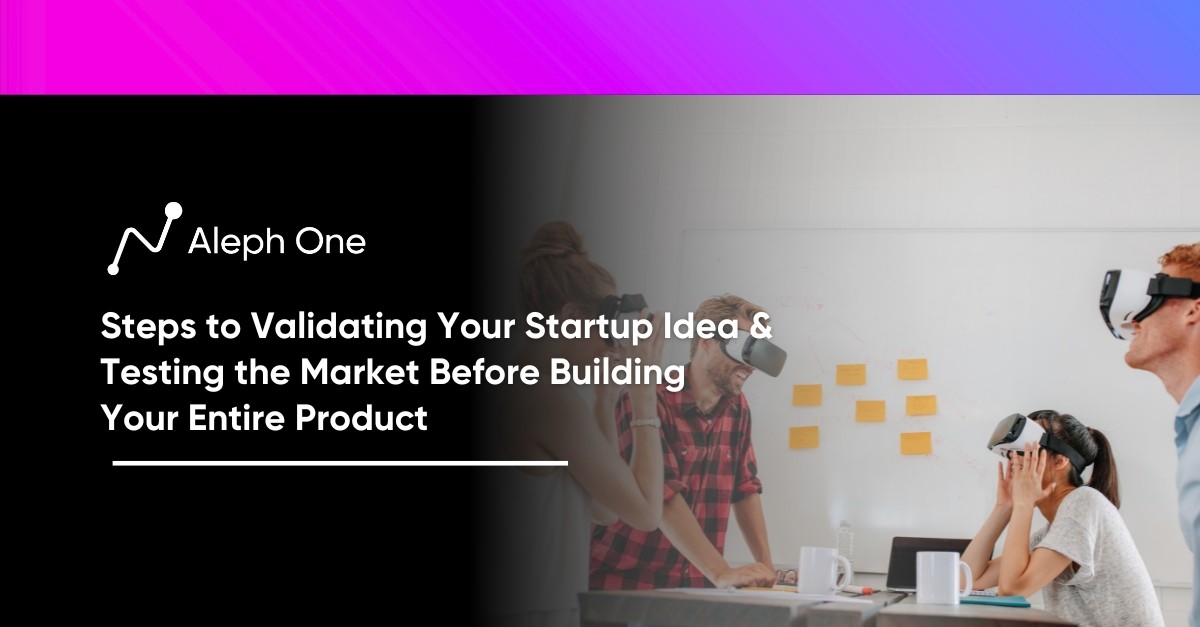Let’s work together to build something amazing. Share your project details and our team will reply to figure out the next steps to your success.

Validating a startup idea is crucial for success in the competitive market. Many startups must learn to build products based on assumptions rather than facts, wasting time and resources. The lean validation process offers a solution by allowing startups to test their assumptions and risky ideas early on. By engaging in customer conversations, refining ideas based on feedback, and building a minimum viable product, startups can achieve product-market fit faster and avoid the high costs of developing something no one wants. Continuously testing and validating with customers is the key to long-term growth and success. This article provides insights into the lean validation process, strategies for finding target customers, the power of customer conversations, the importance of minimum viable products, and the value of continuous validation for startups.

The Lean Validation Process: Stop Wasting Time and Money
Many startups waste months or years building products that customers don’t want. The lean startup methodology offers a better approach. By applying a lean validation process, startups can avoid wasting resources on products that don’t fit the market demand.
According to CB Insights, startups fail because of a lack of market need for their product. About 42% of startup failures are due to building something no one wants. Other studies show 75% of venture-backed startups never return cash to investors. The costs of failure are enormous.
Refining Ideas Based on Customer Feedback
The lean validation process aims to prevent these failures by testing assumptions and risky ideas early on. The key is starting with your vision for a solution but getting out of the building to talk to potential customers before building anything. Through conversations, startups can validate or invalidate their most critical assumptions. They can refine their ideas based on customer feedback and ensure they’re solving a real pain point in the market.
Validating Demand Pays Off in the Long Run
By validating demand before building a complete product, startups can achieve product-market fit faster and more efficiently, setting the company up for success and growth. While many founders are eager to build their vision, the patience to validate first pays off hugely. It leads to building only what customers want and will pay for.
Learning Through Experimentation and Feedback
In today’s fast-paced markets, learning quickly is a competitive advantage. The lean validation process embraces learning through experimentation and customer feedback. Startups that validate their riskiest assumptions early and often are far more likely to succeed in the long run. They avoid the devastating costs of building something no one wants and achieve the product-market fit to fuel their growth. Overall, applying lean validation techniques is a must for any startup looking to solve real problems in the market.
Finding Your Target Customers: It’s All About Networking
Identifying your target customers is one of the most essential steps in validating your startup idea. Who are the people that will buy and use your product? The only way to truly understand your potential customers is to engage with them–meet them face to face.
Attend In-Person Industry Events
Networking is vital to finding and connecting with customers. Attend industry events, conferences, and meetups to start conversations with people in your target market. Ask open-ended questions to understand their challenges, pain points, and needs. Look for patterns in their responses to determine if your solution would be valuable.
Reach out to Industry Leaders Online
You can also network by contacting industry influencers and leaders on LinkedIn or Twitter. Explain your startup idea and ask if they know potential customers you could interview. Some may even make introductions on your behalf. Paid social media advertising is another option for boosting your networking reach. Run ads targeting your specific customer segments and include a message inviting people to sign up for a customer interview.
Fuel Your Startup’s Growth for Years to Come
While networking requires time, it is one of the most valuable ways to find potential customers and validate your idea. Speaking with real customers will provide insights that help ensure your startup builds something people want and need. The feedback and connections gained from networking can fuel your startup’s growth for years. Networking your way to your target customers is well worth the effort.
Getting Out of the Building: The Power of Customer Conversations
Talking to real potential customers is one of the most essential steps in validating your startup idea. While networking and online research can provide initial insights, nothing is more valuable than direct customer feedback. Speaking with people face to face or over the phone allows you to ask open-ended questions, gain a deeper understanding of their problems and needs, and identify patterns that point to a viable product solution.
Tips for Effective Customer Interviews
Begin with a Hypothesis
To conduct compelling customer interviews, start by hypothesizing about your target customers and the problems you think they have. Then design open-ended questions to test your assumptions without biasing the respondents. For example, ask, “What are your biggest challenges with [problem area]?” rather than “Does [solution concept] sound appealing to you?” Let the conversation flow naturally and probe deeper into exciting responses.
Look for Trends in Customer Responses
Look for trends in customer feedback that either validate or contradict your hypothesis. Pay attention to what they say and how they say it—their tone of voice, level of enthusiasm, and what they don’t say. These clues can reveal insights beyond their direct answers. You may discover needs, problems, or solutions you hadn’t considered before.
Startups Shaped by Customer Feedback
Many successful startups point to initial customer conversations as pivotal moments that shaped their business. The founders of the apartment rental site Airbnb spoke with travelers and hosts in New York City, discovering that people were interested in unique spaces and personal connections. This led them to reposition their service around “belonging” rather than low-cost accommodation. Video messaging app Glide initially thought teens would use their service, but after talking to potential users, they found most interest from adults connecting with long-distance friends and family.
While building a minimum viable product and other validation techniques are helpful, there is no substitute for direct customer conversations. Speaking with real people will provide the most profound insights into whether your startup idea has the potential for product-market fit. The feedback you gain can help you pivot into a new direction or give you the confidence to build your solution. Continuously engaging with customers through your startup’s journey will keep you on the path to success.
Minimum Viable Products: Don’t Build It Until They Come
One of the most costly mistakes startups make is building a full-featured product before validating demand in the market. A minimum viable product, or MVP, is a tool that allows you to test your idea with real customers before investing heavily in development. An MVP has just enough features to be usable by early customers, who can then provide feedback to help determine if you should continue building the product.
There are several strategies for developing an MVP. You can:
- Create a landing page describing your product and collect the email addresses of interested customers. This validates demand without actually building anything.
- Launch a crowdfunding campaign to see if people will commit money to your idea.
- Build a basic digital prototype or demo to show customers. A “concierge MVP” involves manually delivering your product or service to customers to test the experience.
The key is to start simple and avoid over-engineering your MVP. Get customer feedback quickly, and be prepared to pivot based on what you learn. An MVP is meant to validate or invalidate your hypothesis, not just attract early adopters. Many founders are surprised when their MVP testing shows a need for more customer interest. But it’s better to fail fast and change direction than spend years building a complex product no one wants.
Fast-Track to Validation
An MVP allows you to begin the validation process as early as possible. Be sure to get a perfect, fully-functional product. Get started with an MVP, learn from real customers, and build from there. An MVP can save you time, money, and heartache by ensuring you’re solving a problem that people care about before you invest heavily in development.
Pivoting to Success: How Customer Feedback Fuels Growth
One of the most challenging but essential lessons for startups is that their initial idea may fail to succeed. Customer feedback and market conditions often require startups to pivot to a new product, business model, or strategy to achieve growth. Pivoting is challenging, requiring admitting your original hypothesis was wrong and changing course. However, successful startups can pivot based on facts, not opinions.
Determining When a Pivot is Necessary
To determine if a pivot is needed, analyze the feedback and data you’ve collected from customer interviews, MVP tests, and other validation efforts. Look for patterns that indicate your current product or model isn’t resonating. For example, if only some customers say they would pay for your solution or the problem you’re solving isn’t a high priority for them, it may be time to pivot.
Successful Startups That Had to Pivot
Some famous startups that successfully pivoted include PayPal, which initially provided security software for handheld devices but pivoted to online payments; Slack, which started as an online game but pivoted to workplace collaboration software; and Groupon, which pivoted from a fundraising platform to daily deals. These startups were able to pivot while maintaining momentum by continuing to gather customer feedback, reusing existing resources and technology when possible, and communicating changes to their team and users.
Be Prepared to Pivot More Than Once
While pivoting, stay focused on the key metrics defining success for your new direction. Continue validating your updated hypothesis and making adjustments based on new feedback. Startups often go through multiple pivots before finding the right product-market fit. With each iteration, you’ll gain valuable insights that bring you closer to growth and success.
Validation is ongoing, even after you’ve achieved the initial product-market fit. Leading startups continue to test with customers through beta testing new features, closely monitoring reviews and feedback, and conducting annual surveys. You’ll build a startup poised for sustainable growth by continuously validating with your customers. Overall, the ability to pivot based on facts and constantly test your hypotheses separates successful startups from the rest.
Strategies to Continuously Test Your Startup
Beta Test New Features
One way to continuously validate your product is through beta testing new features with select customers. This lets you get feedback on potential updates before rolling them out to your entire user base. Surveys, interviews, and focus groups with beta testers can uncover pain points in the new experience and opportunities for improvement. Many tech companies like Google, Facebook, and Slack frequently beta-test new features with a subset of their customers before making updates publicly available.
Reviewing Customer Feedback
Monitoring customer reviews and feedback is another simple way to validate your product continuously. Look for trends in reviews and comments across platforms like your website, app stores, social media, and third-party review sites. If multiple customers report the same issues or request the same new features, it highlights opportunities to improve your product. Regularly respond to reviews and feedback, and notify customers when their suggestions have been implemented.
Conduct Regular Customer Surveys
Annual or biannual customer surveys are also helpful for continuous validation. Surveys allow you to ask targeted questions about the customer experience and what they want to see changed or improved. Look for feedback that conflicts with your business assumptions or goals to determine if a pivot is needed to meet customer needs better. Promising startups like Slack, Airtable, and Calendly conduct regular surveys to ensure their products continue to satisfy their target customers.
While initial validation is vital to finding product-market fit, it is more than a one-and-done process. Leading startups continuously test their products with customers through beta testing new features, monitoring reviews and feedback, conducting periodic surveys, and more. Continuous validation helps fuel sustainable growth by ensuring your startup’s product continues to meet the evolving needs of your target customers. The validation process always continues.
What are some strategies to find target customers for networking purposes?
To find target customers for networking purposes, startups should attend industry events, conferences, and meetups and converse with people in their target market. Additionally, they can contact industry influencers and leaders on LinkedIn or Twitter, asking for introductions to potential interviewees. They can also consider paid social media advertising to target their specific customer segments and invite people to sign up for customer interviews.
How can startups effectively conduct customer interviews to validate their business ideas?
Startups can effectively conduct customer interviews by first developing a hypothesis about their target customers and their problems and then designing open-ended questions to test their assumptions without biasing the respondents. They should let the conversation flow naturally, probe deeper into interesting responses, and look for trends in customer feedback to either validate or contradict their hypothesis, ultimately gaining valuable insights about their customers’ needs and problems.
What approaches can be used to create a minimum viable product (MVP) for testing purposes?
Several approaches can be used to create an MVP for testing purposes. Startups can create a landing page describing their product and collecting email addresses of interested customers, launch a crowdfunding campaign, build a basic digital prototype or demo, or even use a “concierge MVP” where they manually deliver the product or service to customers. The goal is to start simple, gather customer feedback quickly, and be prepared to pivot based on the insights gained from the MVP testing process.
Get the latest news and updates from Aleph One in your inbox.



